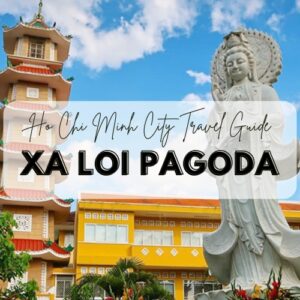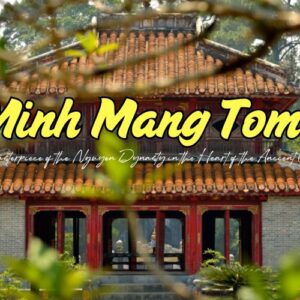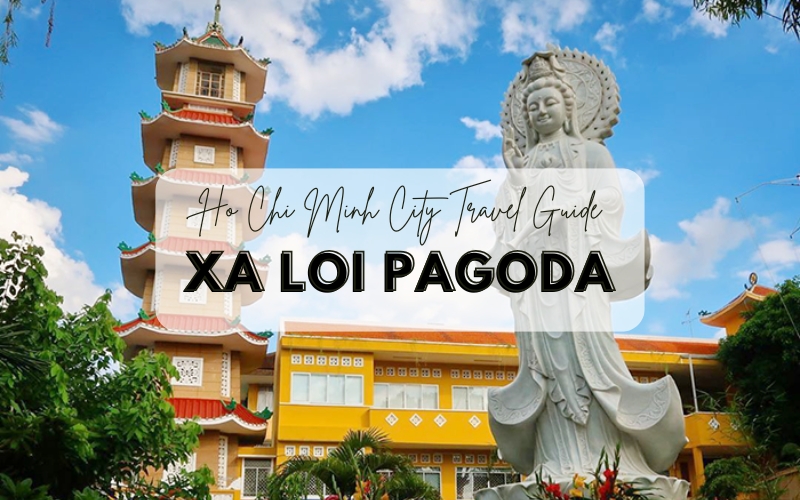
Xa Loi Pagoda is a famous spiritual tourist destination in Saigon today. With an age of more than 50 years, Xa Loi Pagoda is associated with many important historical milestones of Vietnamese Buddhism. Let’s explore this most sacred and famous pagoda in Saigon as well as the reason why this pagoda is known as a treasure of Vietnamese Buddhism in the article below!
General information about Xa Loi Pagoda
Address: 89 Ba Huyen Thanh Quan Street, Ward 7, District 3, Ho Chi Minh City
Opening hours: Xa Loi Pagoda is open every day of the week. Opening hours and daily activities of the pagoda take place according to the following schedule:
- Morning: 7:00 – 11:00.
- Noon: 14:00 – 17:00.
- Evening: 18:00 – 19:00.
- On holidays, the pagoda is open from 7:00 to 21:00 to be able to welcome believers and visitors more thoughtfully.
Xa Loi Pagoda is an old pagoda recognized as one of the important relics of Saigon, included in the list of City-level relics of Ho Chi Minh City. It is considered the largest ancient temple in Saigon, with an extremely large campus with an area of about 2400m2. The pagoda is famous for its modern architecture but still imbued with Vietnamese cultural identity.
Along with Ngoc Hoang Pagoda and Phap Hoa Pagoda, this place is also considered a cultural symbol of Saigon. This is an extremely valuable relic, closely associated with the historical vestiges of the country, preserving the historical mark of the struggle of Buddhism against the Ngo Dinh Diem dictatorship of religious discrimination and oppression. Moreover, this place is also the place where important milestones were formed in the process of unifying Vietnamese Buddhism, from its inception until Buddhism was completely unified.
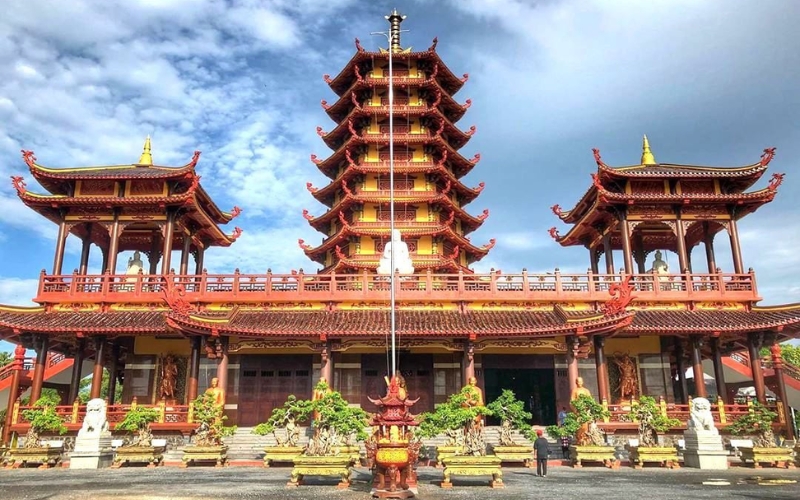
Xa Loi Pagoda
>>> Embark on our Ho Chi Minh City tours, where bustling streets meet rich history, stunning architecture, and dynamic local culture. Whether you’re a foodie, a history buff, or simply looking to soak in the energy of this iconic city, our tours offer something for everyone.
History of Xa Loi Pagoda
Xa Loi Pagoda was built in 1956 and completed in 1958. Previously, the pagoda worshiped the Buddha’s relics, so the abbot of the pagoda named the pagoda Xa Loi to please the people.
The history of the pagoda is closely linked to the self-immolation of monk Thich Quang Duc to protest the policy of oppressing Buddhists of the Ngo Dinh Diem government. After the event, the body of monk Thich Quang Duc was buried right at Xa Loi Pagoda in Saigon. Nowadays, there are still many photos and documents about the event in 1963 around the pagoda, attracting many Buddhists and tourists coming here to learn and express their respect and remember the monk’s sacrifice.
Later, the pagoda became the official meeting place of the South Vietnam Buddhist Association. Xa Loi Pagoda was renovated and restored only once in 2000. Therefore, the beauty of the original architecture is still preserved.
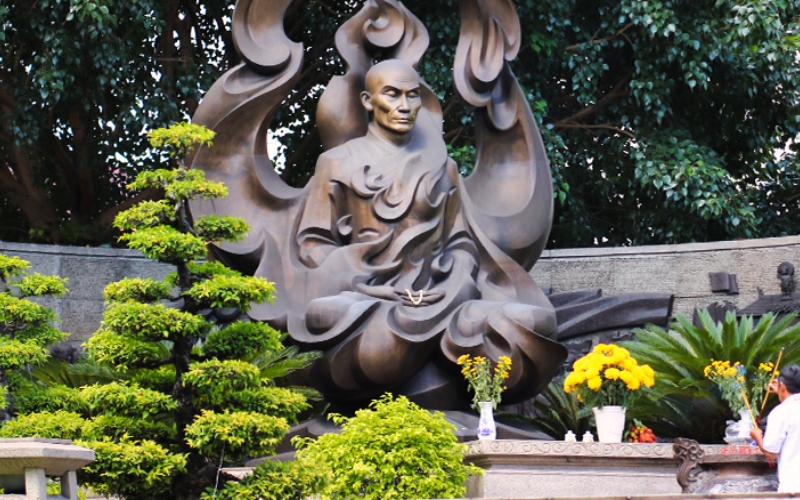
memorial statue of monk Thich Quang Duc
How to Get to Xa Loi Pagoda
With these detailed transportation options, you can easily get to Xa Loi Pagoda and enjoy the peaceful atmosphere while immersing yourself in the rich cultural heritage of Ho Chi Minh City. Here is a detailed guide on how to get there:
- By taxi or ride-hailing app: For the most comfortable travel, book a taxi or motorbike through reputable apps such as Grab, Xanh SM or Be. Prices may vary depending on the type of vehicle and the distance you travel, but will mostly range from 2-4 USD. This option is suitable for large groups or those who are not familiar with the roads here.
- By motorbike or private car: This is one of the most comfortable and flexible ways to get to Xa Loi Pagoda. You just need to enter the name or address of the pagoda into Google Map or other search apps to get to the pagoda. There are many parking lots around the pagoda with fees ranging from 5-10,000 VND for motorbikes and a little higher for cars. However, you will need an international driving license and obey traffic laws.
- By bus: the city’s extensive bus system makes it easy to get to the temple from anywhere. Find the right bus route using a map app or simply ask your hotel staff. Bus fares are usually around 7,000 VND per trip, making it the cheapest option but you will have to walk a little further from the stop to the temple.
- By foot or bike: If you are also in District 3 or the surrounding area, walking or cycling to the temple is an eco-friendly option. The area is pedestrian-friendly and the streets around the temple, such as Nguyen Thi Minh Khai and Ly Thai To, are lined with trees and local shops, making for a pleasant journey. This is a sustainable and relaxing way to get to the temple while exploring the neighborhood.
What to See at Xa Loi Pagoda
Main Hall
The main hall is the area with the most typical architecture of Xa Loi Pagoda. The main hall has an area of over 400m2, spacious, airy and receives natural light from the high, long window system. Inside the main hall, there are currently 15 very vivid paintings, simulating the history of Buddha from birth to nirvana. In addition, in the main hall, there is a jade tower in the shape of a Bodhi leaf, inside there is a sacred Xa Loi jade placed high above, next to the statue of Buddha Sakyamuni.
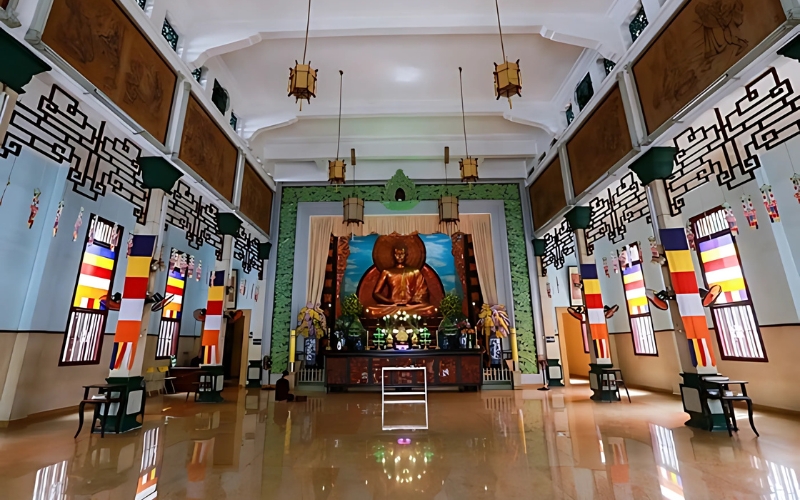
The main hall
Tam Quan Gate and the seven-story bell tower
The pagoda has two Tam Quan gates, the main gate is on Ba Huyen Thanh Quan Street and the secondary gate is on Su Thien Chieu Street. Moving from the three-door gate into the pagoda grounds, visitors will be amazed by the 32m-high seven-story bell tower, which holds the record as the tallest bell tower in Vietnam today.
The tower is built with a curved roof and painted red and yellow – the typical colors of Buddhist architecture. The structure of the bell tower consists of 7 floors, each floor has an octagonal structure and will worship a different Buddha. The highest floor of the bell tower will be the ancient tower, inside there is a large bell weighing up to 2 tons with a diameter of 1.2m, 1.6m high and cast in bronze. In addition, when looking to the right of the hall, you will see the Bodhi tree brought from Colombo, Sri Lanka and the 6-meter-high statue of Bodhisattva Avalokiteshvara cast in 1958.
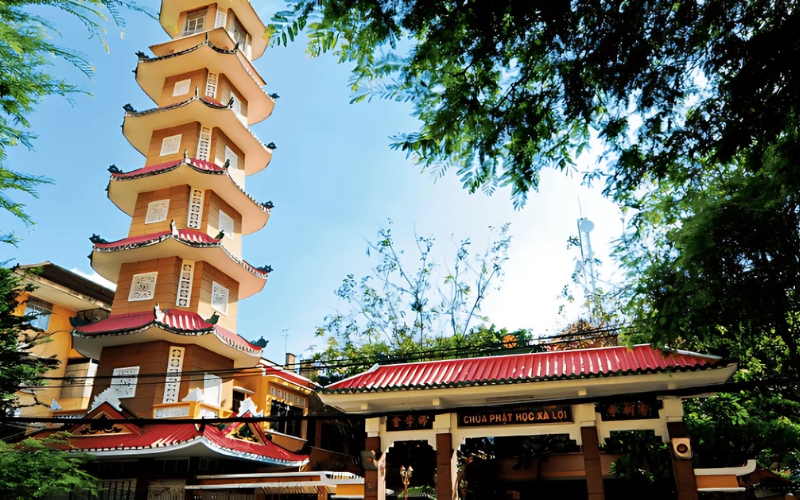
Tam Quan Gate and the seven-story bell tower
Precious Dharma instruments
Currently, Xa Loi Pagoda still preserves many precious Dharma instruments associated with history such as:
- The horizontal plaque with the 4 words “Dong Thuy Phap Vu” written by the Empress Dowager Tu Hy.
- The silver tower containing the Xa Loi jade was donated to the pagoda by Dharma Master Dien Boi from Taiwan
- The bronze tower with a unique Indian design was donated by the Indian Consulate in Vietnam.
- The pagoda preserves an ancient Pali scripture on palm leaves, which is over 1000 years old. The content of the sutra records the precious words of the Buddha when he turned the wheel of dharma.
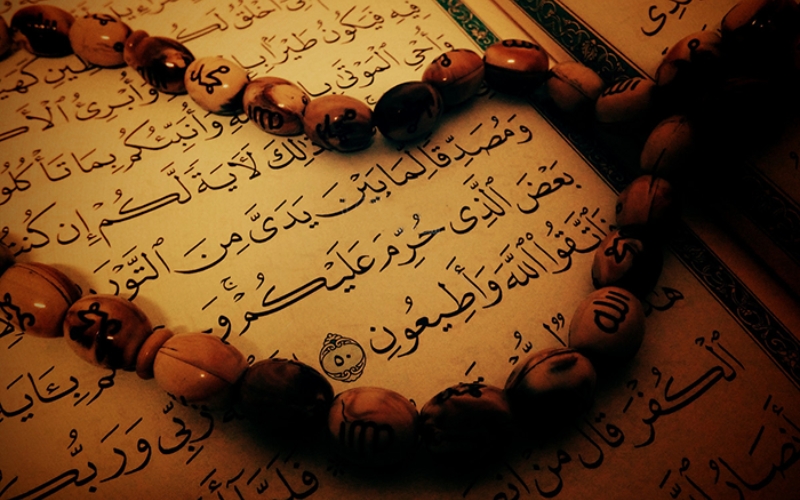
Pali Canon dating back over 1000 years at Xa Loi Pagoda
What to Do at Xa Loi Pagoda
Learn about Buddhist activities
Xa Loi Pagoda offers visitors the opportunity to immerse themselves in Vietnamese Buddhist activities. Inside the main hall, you can observe monks chanting, devotees offering incense, or others meditating in silence. These rituals are an integral part of Buddhist life, reflecting themes of compassion, mindfulness, and devotion. Visitors can participate respectfully by offering incense, bowing before the altar, or simply sitting quietly in contemplation. Participating in these activities provides a deeper connection to the purpose of the temple and the culture it represents.
You can refer to the sermon schedule and practice activities according to the following time frame:
- Speech schedule: the pagoda holds Buddhist sermons every Sunday morning.
- Dharma classes for lay Buddhists: every Sunday.
- Calligraphy class schedule: Classes are held every Monday, Tuesday and Sunday taught by calligrapher Chinh Trung.
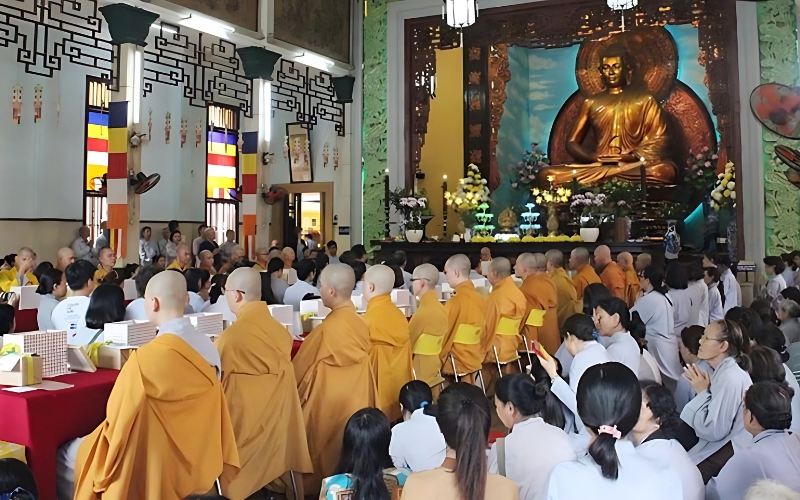
A Dharma class at Xa Loi Pagoda
Attend a Buddhist ceremony
If you visit Xa Loi Pagoda during important holidays such as Vesak, the full moon of the first lunar month or the Lunar New Year, you will have the opportunity to witness a traditional Buddhist ceremony with rich cultural and spiritual significance. Monks and devotees gather in the main prayer hall or courtyard to chant, pray and perform rituals. Visitors can observe quietly or even join in the offering of incense or flowers. This is a unique way to experience Vietnam’s Buddhist heritage up close and you will gain a deeper appreciation for the spiritual life of the local community.
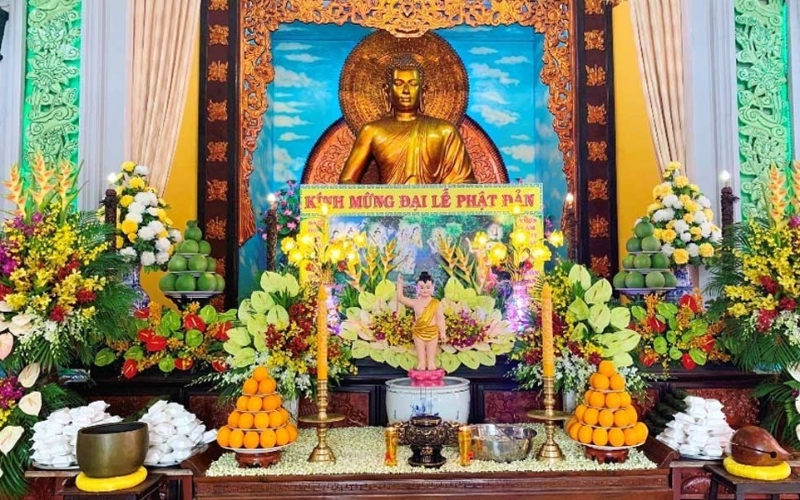
Vesak at Xa Loi Pagoda
>>> Ho Chi Minh City is a hub of cultural celebrations and traditions. Here’s a look at the top festivals that offer a unique glimpse into its rich heritage and dynamic spirit.
Visit the Library
Xa Loi Pagoda has a Buddhist library, which is a treasure trove for those interested in Vietnamese spirituality, philosophy and culture. The collection includes over 3000 volumes of Buddhist teachings, ancient scriptures and books on meditation methods. Especially when you come here, you will admire 2 sets of extremely valuable Chinese Tripitaka along with some calligraphy paintings, calligraphy, Buddhist books, literature books, philosophy, and Buddhist cultural products, … The library will be open from 8 AM to 11 AM and 2 PM to 4 PM every day except Sunday afternoon and Monday afternoon.
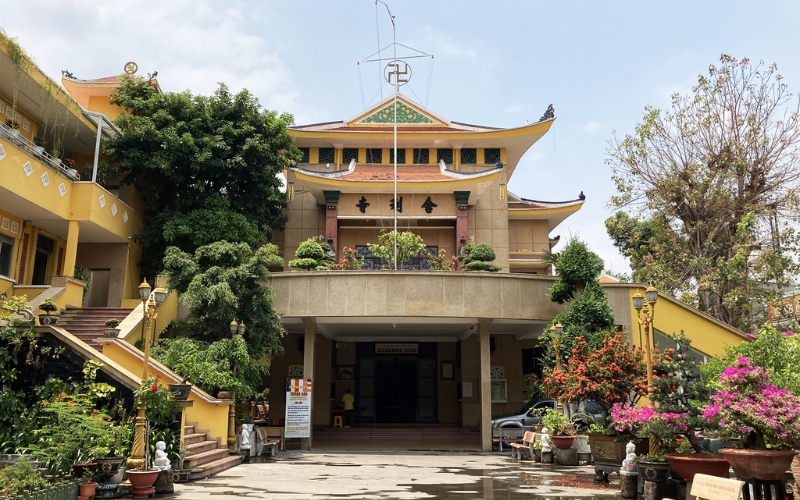
The library has over 3000 Buddhist teachings and ancient scriptures
Enjoy the peaceful garden
The garden surrounding Xa Loi Pagoda has many lush green trees and carefully maintained colorful flower paths, creating an attractive space for meditation or relaxing with nature. In addition, the campus also has benches and shady areas for visitors to rest and enjoy the peaceful atmosphere, making this the perfect place to relax away from the hustle and bustle of the city.
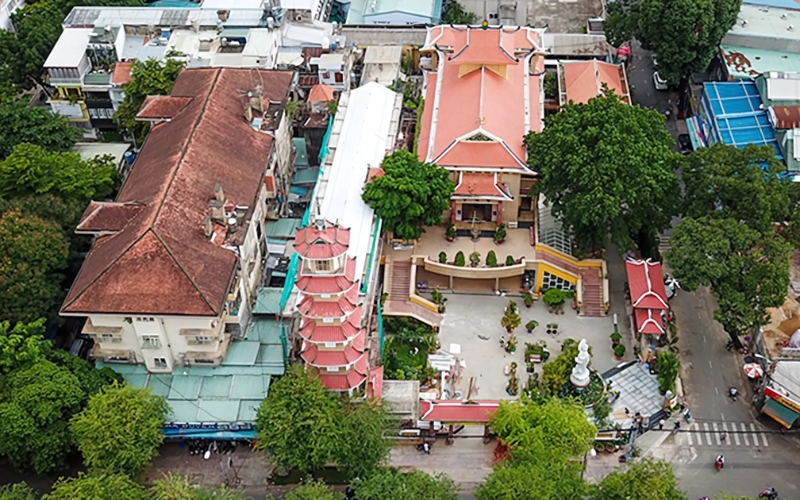
Xa Loi Pagoda from above
Travel tips when visiting Xa Loi Pagoda
As a spiritual tourist destination, visitors to the temple need to pay attention to their behavior and conduct appropriately. Especially at Xa Loi Pagoda – where many statues, treasures, and precious religious objects are kept, visitors need to note the following:
- Light incense moderately, avoiding affecting the atmosphere in the temple.
- Wear modest, polite clothing, and choose clothes that cover the shoulders and knees such as long pants, long skirts, and shirts with sleeves. Avoid wearing shorts or clothes that are too thin because these outfits are considered disrespectful.
- The best time to visit the temple is early morning or late afternoon because the weather is cool and fewer crowds, creating a peaceful atmosphere for exploration and contemplation. If you like vibrant festivals, festivals such as Vesak or Lunar New Year will bring you unique cultural insights.
- Respect local customs such as removing shoes before entering the prayer room, avoid pointing your feet towards statues or altars as this is considered disrespectful, not touching sacred objects unless explicitly permitted, and not speaking loudly, especially when in a Buddhist temple.
- Be careful to keep your personal belongings safe during crowded holidays.
- Not all areas are allowed to take photos; please read the notices at each attraction carefully to understand the rules. Avoid using flash and do not take photos of worshippers without their consent.
Xa Loi Pagoda is not only a place of worship but also a peaceful place of meditation in the heart of bustling Ho Chi Minh City, bringing a unique blend of spirituality, history, and cultural heritage. Besides this pagoda, there are still many other unique tourist destinations waiting for you to explore. Please contact us if you are planning to explore the largest pagodas in Ho Chi Minh City.
Read more:

